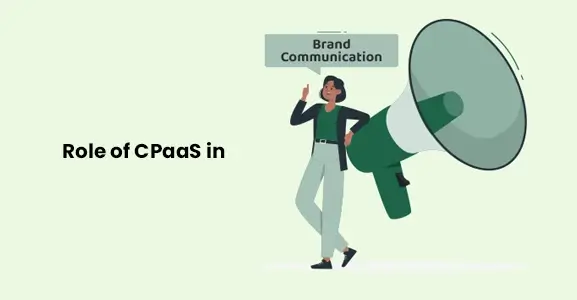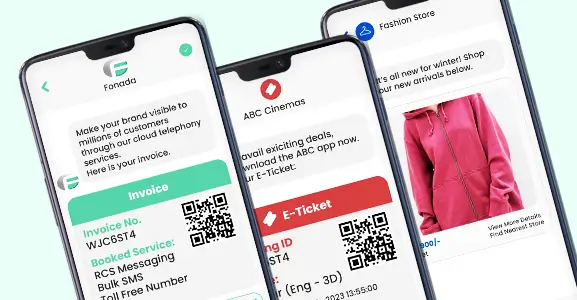In any organization, various management levels exist, particularly in larger and more complex setups. Managing such structures can be challenging, especially with a sizable customer database. That’s why businesses are increasingly adopting cloud telephony solutions to facilitate effective communication within the workforce. However, relying solely on advanced CPaaS solutions is not sufficient for maintaining an effective communication trail among all employees and customers.
To make a business successful, it’s vital for all employees to communicate well and collaborate efficiently on a regular basis. This means ensuring a continuous and smooth flow of information. In business, communication is not limited to talking to customers only. It heavily relies on getting feedback and prompting smoother communication among customers as well as employees. It’s like the heartbeat of a business, essential for its growth and progress.
This blog post aims to give you a clear picture of “what is business communication” and how it helps enterprises. It will cover everything from understanding how communication works to providing practical tips for overcoming common challenges. Whether it’s about getting feedback or breaking down communication barriers, this guide will help your business create a communication process that fosters growth and long-term success.
What Is Business Communication? (Definition)
In layman’s terms, business communication definition revolves around how individuals exchange information within a work or business environment. It includes talking, writing, sharing ideas, and leveraging advanced communication solutions to ensure everyone understands what needs to be done. It helps teams work together, make decisions, and keep the business running smoothly. Whether it’s emails, meetings, or even just chatting with colleagues, it’s all about getting the right messages across to achieve common goals in a company.
Read More: What Is Internet Communication & How Can We Communicate Over The Internet?
Importance And Objectives Of Business Communication
Business communication meaning refers to the process of exchanging information within a company or with external parties to achieve business objectives effectively. It is like the glue that holds different aspects of a business together.
It helps in expressing ideas, making plans, carrying out decisions, reaching agreements, handling orders, making sales, conducting successful meetings, and maintaining a healthy feedback loop with both employees and customers. Without good communication, these processes could become confusing, inefficient, or prone to errors.
The objective of business communication lies in:
- Presenting options/new business ideas: Sharing and discussing new ideas or choices for the business.
- Making plans and proposals (business writing): Writing down and explaining plans and suggestions for the business.
- Executing decisions: Carrying out and putting into action the choices and plans made for the business.
- Reaching agreements: Coming to mutual understandings or decisions with others involved in the business.
- Sending and fulfilling orders: Communicating and making sure that orders placed by customers are delivered as expected.
- Successful selling: Effectively communicating to convince customers to buy products or services using IoT (Internet of Things)
- Effective meetings: Making sure that meetings are productive and achieve their goals.
- Providing feedback to employees and customers: Sharing thoughts and comments with employees and customers helps them understand areas of excellence and improvement. This practice fosters healthy customer relationships and motivates employees.
Types Of Business Communication
We can categorize business communication in three types:
Under The Organizational Structure:
- Formal Communication: This is a structured way for employees to talk about work-related matters in a business.
Example: Imagine a scheduled meeting where employees discuss work projects using a planned agenda. - Informal Communication: This is more casual communication that may or may not be about work.
Example: Think of chatting with a colleague at the coffee machine about weekend plans or hobbies.
Taking Into Consideration The Direction:
- Downward Communication: Information flows from top management to lower-level employees. Managers use this to convey goals, procedures, rules, decisions, and instructions to subordinates.
Example: Picture a manager informing their team about new company policies during a team meeting. - Upward Communication: This is the opposite, where information moves from lower-level employees to higher management. The purpose is to provide feedback, suggestions, requests, and other details to higher-ups.
Example: Consider an employee sharing feedback or ideas with their supervisor about improving office processes. - Horizontal Communication: This involves communication among coworkers at the same hierarchical level. It is crucial for different parts of the organization to collaborate and work well together.
Example: Think of colleagues from different departments coordinating on a joint project through regular discussions. - External Communication: This refers to interactions with individuals outside the company, such as customers, stockholders, suppliers, partners, and regulatory organizations. External communication supports increased sales, efficient operations, and overall company sales performance.
Example: Imagine a company reaching out to customers through emails or holding meetings with suppliers to discuss product orders.
According To The Mode Of Expression:
- Oral Communication: This involves spoken words and discussion on customer engagement strategies such as face-to-face meetings, seminars, video conferences, and lectures. It relies on body language and verbal intonation to convey meaning.
Example: Picture a team gathering for a face-to-face brainstorming session where everyone shares their ideas. - Written Communication: This includes emails, texts, notes, papers, and other written forms. These methods simplify communication by providing clear information and allowing recipients to clarify any misunderstandings.
Example: Think of sending an email to a colleague with project updates or using a written report to communicate key findings in a business meeting.
Read More: How To Get A Temporary Phone Number?
Roles And Objectives Of Business Communication
The success of a company depends on how well its corporate communications work. Here is how it can help the business:
-
Top To Bottom
Top-to-bottom is a communication strategy within an organization in which data flows from the top down.Businesses need a fast way to spread top-level decisions throughout the company. As a result, many companies use top-to-bottom communication to ensure that data flows freely from top to bottom.Top-to-bottom communication may be highly powerful when executed correctly. It can break through silos and boost team members’ confidence. In the worst-case scenario, it can slow down production and compel employees to conform to an overly hierarchical organization.
-
Peer To Peer
A huge proportion of our everyday activities depends on our relationship with coworkers. Yes, a solid relationship with your supervisor is vital, yet some go days without communicating.
Answering questions, sharing information, and giving feedback to coworkers can help you complete tasks. Excellent communication boosts workplace enjoyment and vitality.
-
Bottom To Top
It distributes information from lower-level supervisors and team members throughout the organization. Bottom-up communication is less common but very effective.
It lets employees give feedback and contribute to higher-level decision-making.
Why Effective Business Communication Matters?
Effective business communication is crucial for several reasons:
Democratization:
- In organizations using democratic decision-making, hearing from underrepresented groups is more likely.
- A strategic approach to business choices, coupled with a culture of sharing information across the entire organization, enhances planning.
Boost Morale And Motivation:
- Vital for increasing employee productivity.
- Helps employees grasp plans, procedures, challenges, and corporate goals, leading to improved productivity.
Improve Relationships:
- Facilitates the exchange of ideas and needs between employees and management.
- Healthy labor relations contribute to stability and overall success.
Job Fulfillment:
- Effective, fair, and straightforward communication fosters understanding between employees and management.
- Results in greater job satisfaction, aligning individuals with business communication objectives.
Higher Efficiency:
- Fosters collaboration among employees, promoting mutual trust and understanding.
- Enables effective duty performance and reduces the likelihood of errors in assigned tasks.
Smooth Operation Of Business:
- Helps managers run businesses more efficiently by facilitating tasks like planning, directing, organizing, and controlling.
- Quality leadership relies on a successful and efficient business communication system.
Facilitates Decision Making:
- Current knowledge is essential for effective decisions.
- Managers use effective communication to gather information from various sources, integrating it for informed decision-making.
Proper Planning:
- Enables organizations to develop excellent plans and policies.
- Precise data, communicated effectively, is essential for the timely development and execution of policies and plans.
Minimize Conflicts:
- Clear and effective communication allows business partners to share information easily.
- Results in fewer conflicts, arguments, and disagreements among various stakeholders.
How To Smoothen Your Business Communication Process?
Many employees feel that the way their companies communicate internally could be improved, with 29% expressing this sentiment. To enhance your process of business communication, follow these straightforward steps:
Business Communication Audit And Goals
- Every organization, regardless of size, should have a communication strategy.
- Identify areas that need improvement and prioritize them.
- The sender initiates the communication process by planning and writing the message.
Message Coding Format
- Allocate sufficient time for this task, especially for larger businesses.
- The sender formats the data for transmission, turning it into a visual representation like text or video.
Selecting A Channel
- Choose communication modes that align with your business goals and interactions among primary groups.
- No manual dictates the best tools, so the sender selects the most appropriate channel for the audience.
- Examples include YouTube videos, social media posts, and blog articles.
Process Documentation
- Document your actions during setup and make them accessible to the entire business.
- This serves as a guide for employees to follow the communication strategy in various scenarios.
- It simplifies the understanding of communication methods, especially for new employees.
Feedback
- Feedback is must for understanding the effectiveness of the message.
- Encourage two-way communication to receive feedback from recipients.
- Both PR and marketing benefit from this interactive communication approach.
Read More: What Is Call Detail Record (CDR) ? (12 Key Benefits)
Methods Of Business Communication
It depends entirely on the circumstances to determine which option is superior or inferior for your business.
The following corporate communication approaches are relevant to any or all situations:
1. Digital Communication
This includes communications networks such as email and instant messaging. The advantages of emails and text messages include having efficient personal discussions in a busy workplace setting and simultaneously sharing a message with many individuals — ranging from several to hundreds.
2. Telephone Meetings
Phones have made efficient and fast-paced meetings possible anywhere. It allows for a better exchange of ideas than written communication because of the tone of voice and other non-verbal signals. Cloud phone systems accelerate onboarding and teamwork.
3. Video Conferencing
Video conferencing technology has enabled distant workers to meet regularly in in-person meetings. It has elevated the concept of phone meetings to the next level as one can see face expressions and reactions as well.
4. In-Person Meetings
In-person meetings can expedite the implementation of business ideas. According to research, in-person encounters generate better ideas than virtual ones. However, meetings must have a solid agenda.
5. Official Reports And Documentation
Documenting activities that influence other individuals and departments is essential for a successful business communication system. Referring to a formal document at any time reduces confusion and improves communication.
6. Presentations
Meetings with group members often include PowerPoint presentations and reports. These are excellent for sharing innovative thoughts in a structured manner that allows for questions and explanations.
7. Discussion Boards And Faqs
An internal space for employees to review FAQs on departmental issues and ask new ones to improve productivity and knowledge.
8. Surveys
Surveys—internal and external—are useful for gathering input and ratings on crucial topics. Surveys allow a continuous cycle of improvements based on customer feedback and provide a communication line across all organizational levels.
9. Customer Relationship Management
This may involve any consumer relations-related endeavor. Live chat, CRM, onboarding, reviews, and more are a few examples.
Read More: Understanding Inbound And Outbound Meaning For Smooth Business Communication
Functions Of Business Communication
One important part of talking within a company is ensuring people understand what they should do. When team members know their roles and how they contribute to the company’s goals, they work together better. Employees figure out their tasks by working together and understanding their duties.
Giving Useful Feedback
Another important part of business talk is giving employees and customers timely and clear feedback. Employees do better when they regularly hear about their work and what skills they can improve. This helps them see what they’re good at and where they can get better. Getting feedback from customers and stakeholders also helps a company improve its products and services. Communication within a company involves things like job descriptions, goals, and how well people are doing in their roles.
Talking To Clients
To persuade potential customers, clients, or business partners, businesses often use communication to make a convincing argument. This kind of talk can happen in person or in writing. For instance, a salesperson might convince a customer over the phone or through ads in a newspaper for a product launch. This type of communication needs to be trustworthy and appeal to emotions. It can also help with public relations and building a brand.
Encouraging Employees To Decide Better
Companies use communication as a tool to help employees make good decisions about their daily tasks and long-term goals. Bonuses or rewards motivate people to contribute to the company’s growth and meet goals faster.
Building Social Connections
Communication is crucial in helping employees build social networks. Some companies encourage all employees to interact with their bosses, while others follow a more structured chain of command.
Business Issues Resolved Through Effective Business Communication
Effective business communication is crucial for resolving various issues within an organization. Here are some common business issues that can be addressed through effective communication:
Unclear Roles And Responsibilities
When employees are unsure about their tasks and roles, it can lead to significant problems in a business. Even in companies that strive for a collaborative environment, failure to clearly explain responsibilities can result in employees assuming others will handle issues. This lack of clarity risks having an ineffective and dishonest workforce. Defining roles, authority, and success criteria is crucial for improving business operations, staff productivity, and retention rates.
Communication Gaps Between Departments
In organizations, different departments often work independently on assigned tasks. While this can be efficient, it becomes a problem when departments don’t communicate or understand each other’s roles. Communication across departments is vital for achieving overall organizational objectives, especially in larger companies. For instance, if the finance department is unaware of the activities of the market research department, it can lead to operational failures. Providing a comprehensive overview ensures streamlined operations.
Poorly Crafted Written Communications
Essential information, such as new projects, organizational updates, and workflows, is often communicated in writing. However, poorly written messages can confuse and frustrate employees. Investing time and resources in creating clear, well-written communications ensures that recipients can absorb the information and respond appropriately.
Negative Impact On Customer Service
Inadequate internal communication negatively affect scustomer service in two ways. First, employees dealing with customers need access to relevant information. Second, low employee morale can harm the overall customer experience. Effective business communication is crucial to providing excellent customer service.
Conclusion
Clear communication is essential for employees to establish connections and foster a positive work environment. Some organizations encourage open communication among employees and superiors, while others follow a hierarchical chain of command. Regardless of the approach, the purpose of business communication is to create a competitive edge in the business world. Fonada offers various services to help businesses explore profitable alternatives.
FAQs
Effective business communication fosters collaboration, ensures clarity, builds trust, enhances productivity, and facilitates informed decision-making. It is crucial for building strong relationships, boosting efficiency, and achieving organizational success.
Enhance internal communication by implementing clear channels, using collaboration tools, fostering an open culture, providing regular updates, encouraging feedback, and utilizing platforms for seamless information sharing, ensuring transparency and unity.
Non-verbal communication, encompassing gestures, body language, and facial expressions, complements verbal messages, conveying emotions, intentions, and context. It enhances understanding, strengthens relationships, and influences perceptions in interpersonal interactions.
Cross-cultural business communication faces challenges such as language barriers, differing communication styles, cultural nuances, misinterpretations, and varying expectations. Overcoming these challenges requires cultural awareness, adaptability, and effective intercultural communication skills.
A business communications plan is a strategic outline detailing how a company communicates internally and externally. It specifies goals, target audiences, channels, and messaging strategies to ensure effective and consistent communication.
Business communication varies across cultures due to differences in communication styles, etiquette, and language nuances. Understanding cultural norms and adapting communication strategies helps navigate diverse business environments and fosters successful interactions.
Key components of business communication include clear messaging, effective channels (e.g., emails, meetings), proper tone and etiquette, active listening, feedback mechanisms, and adaptability to diverse audiences and cultures for successful information exchange.
Technology plays a vital role in business communication by facilitating efficient information exchange through channels like emails, video conferencing, and collaborative platforms. It enhances connectivity, speed, and accessibility, fostering effective, streamlined communication processes.
Business communication definition refers to the process of exchanging information within an organization or between organizations to achieve business objectives. It encompasses various methods like verbal, written, and visual communication for effective interaction and collaboration.

Dec 11, 2024
Top Contact Center Optimization Tools For 2024
“A thriving business knows how to fetch maximum output from limited resources by optimizing ca... Read More
Nov 13, 2024
What Is Brand Communication? CPaaS Role Explained
Did you ever wonder why some advertisements grab your attention instantly, while others do not? The... Read More
Nov 01, 2024
What Is Automated Messaging And How Does It Work?
Automated messaging or text automation empowers businesses and marketing professionals to connect wi... Read MoreLatest Updates
From Fonada
Industry Insights, Trends, Innovations, Updates, and Case Studies from Industry Experts
View
Customer
Reviews
Discover why our customers love us - read their authentic and heartfelt reviews!
View
Case
Studies
Explore real-life scenarios, offering analysis, and solutions to practical challenges
View
Convert Leads Into Sales With Fonada
Trusted CPaaS Solution Provider








